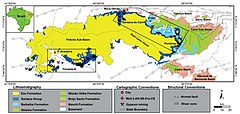| Romualdo Formation | |
|---|---|
| Stratigraphic range: Early Albian ~ | |
 Fossils of Anhanguera (top) and Santanadactylus (bottom) from the Romualdo Formation | |
| Type | Geological formation |
| Unit of | Santana Group |
| Underlies | Exu & Arajara Formations |
| Overlies | Crato & Ipubi Formations |
| Thickness | 2–10 m (6.6–32.8 ft) |
| Lithology | |
| Primary | Mudstone |
| Other | Limestone, shale |
| Location | |
| Coordinates | 7°12′S 39°18′W / 7.2°S 39.3°W |
| Approximate paleocoordinates | 12°12′S 10°42′W / 12.2°S 10.7°W |
| Region | Pernambuco, Piauí & Ceará |
| Country | |
| Extent | Araripe Basin |
 Extent of the Santana Group, to which the Romualdo Formation belongs, in blue | |
The Romualdo Formation is a geologic Konservat-Lagerstätte in northeastern Brazil's Araripe Basin where the states of Pernambuco, Piauí and Ceará come together. The geological formation, previously designated as the Romualdo Member of the Santana Formation, named after the village of Santana do Cariri, lies at the base of the Araripe Plateau. It was discovered by Johann Baptist von Spix in 1819. The strata were deposited during the Aptian stage of the Early Cretaceous in a lacustrine rift basin with shallow marine incursions of the proto-Atlantic. At that time, the South Atlantic was opening up in a long narrow shallow sea.
The Romualdo Formation earns the designation of Lagerstätte due to an exceedingly well preserved and diverse fossil faunal assemblage. Some 25 species of fossil fishes are often found with stomach contents preserved, enabling paleontologists to study predator–prey relationships in this ecosystem. There are also fine examples of pterosaurs, reptiles and invertebrates, and crocodylomorphs. Even dinosaurs are represented (Spinosauridae, Tyrannosauroidea, Compsognathidae). The unusual taphonomy of the site resulted in limestone accretions that formed nodules around dead organisms, preserving even soft parts of their anatomy. In preservation, the nodules are etched away with acid, and the fossils often prepared by the transfer technique.[1]
Local mining activities for cement and construction damage the sites. Trade in illegally collected fossils has sprung up from the decade of 1970, driven by the remarkable state of preservation and beauty of these fossils and amounting to a considerable local industry. An urgent preservation program is being called for by paleontologists.[2]
In addition, the weathering of Romualdo Formation rocks has contributed soil conditions unlike elsewhere in the region. The Araripe manakin (Antilophia bokermanni) is a very rare bird that was discovered only in the late 20th century; it is not known from anywhere outside the characteristic forest that grows on the Chapada do Araripe soils formed ultimately from Romualdo Formation rocks.
- ^ Maisey et al., 1991, pp. 99–103
- ^ Gibney, Elizabeth (6 March 2014). "Brazil clamps down on illegal fossil trade". Nature. 507 (7490): 20. Bibcode:2014Natur.507...20G. doi:10.1038/507020a. ISSN 0028-0836. PMID 24598620.